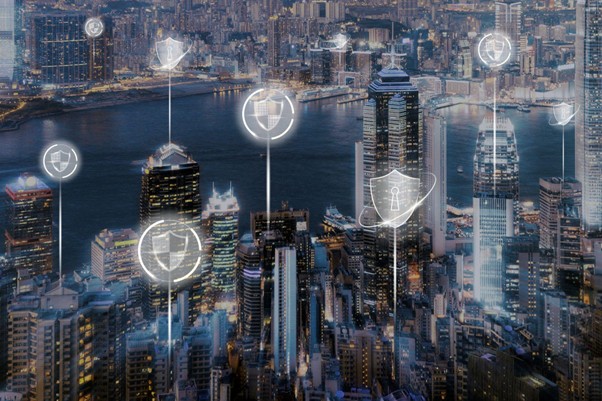
When it comes to cybersecurity, there are many different systems to consider. But before focusing on any one of them, it’s important to start with a basic premise: when building a comprehensive cybersecurity strategy, implement multiple layers of security. This is known as a defense-in-depth strategy. A clear example is: network security vs. endpoint security. Endpoint protection secures individual devices, while network security safeguards the entire network.
As cyber threats become more sophisticated, understanding the balance between endpoint and network security is critical. Choosing one or the other is not enough to protect an organization from modern threats. So, what do they have in common, how do they differ, and what role do they play in an effective security program?
What Is Network Security?
Network security focuses on managing access to and control over the data that travels along the routes and channels that enable communication and data exchange between endpoints. Its goal is to implement a defense approach that protects IT infrastructure and sensitive data from unauthorized access.
With the rise of cloud computing and remote work, network security needs have changed. Users now spend more time outside the office, accessing cloud-based applications rather than through their company’s data center. As a result, many traditional network security solutions no longer offer comprehensive protection.
To address this landscape, organizations are shifting from traditional network security to cloud-based approaches. Decoupling security from the network allows for more robust and flexible protection for distributed workforces.
What Is Endpoint Security?

Endpoint security protects the devices through which users access the internet and the corporate network, such as computers and smartphones. The goal of endpoint protection is to secure these devices against malware, unauthorized access, and data breaches using endpoint detection and response (EDR) systems.
With the continuation of remote work, the number of endpoints connecting to corporate networks has surged. At the same time, attack surfaces are broader than ever. Compromised endpoints can expose sensitive data and provide backdoor access to the network, threatening overall security.
Network Security and Endpoint Security: Stronger Together
Combining network protection with endpoint protection enhances defenses against cyber threats. Endpoint protection platforms help prevent vulnerabilities introduced by endpoint devices, while centralized management tools streamline data sharing between the network and endpoint security.
Complete visibility of users, devices, and data across networks and endpoints is essential for effective security management.
Integrated Threat Intelligence
Sharing threat intelligence between network and endpoint systems enhances overall security capabilities. Collaboration between these systems strengthens an organization’s ability to detect and respond to cyber threats.
Comprehensive Visibility and Control
Integrating threat intelligence with automated prevention significantly improves an organization’s security posture. Centralized visibility of network activity enables faster detection and response to threats using Security Information and Event Management (SIEM) systems to collect and analyze logs across the network.
Best Practices for Implementing Network and Endpoint Security

Protecting an organization’s digital assets and ensuring regulatory compliance is challenging but achievable. To reduce risks and meet compliance requirements, it’s essential to follow best practices when integrating and implementing both systems.
Regular Software Updates
Frequent software updates address vulnerabilities and improve overall security. Periodic audits should identify outdated software and ensure all systems remain current.
Strict Access Controls
Multi-factor authentication (MFA) is crucial for enhancing security by significantly reducing unauthorized access. Regularly reviewing access permissions helps maintain strict control and ensures only authorized users can reach sensitive resources.
Continuous Monitoring
Ongoing monitoring of endpoint activity helps quickly identify and respond to potential security threats. Developing a detailed incident response plan is vital for addressing breaches efficiently.
Top Cybersecurity Threats
Cyber threats typically target endpoints or the broader network, and disruptions in either area pose risks to overall security.
Common Endpoint Threats
- Phishing: Creates gateways for attackers to infiltrate the network through malicious links or attachments, granting access to internal systems and confidential data.
- Ransomware: Can spread across the network, causing widespread disruptions. This results in data loss, operational downtime, and significant costs.
- Software Vulnerability Exploits: Attackers use unpatched vulnerabilities to deploy malware, compromising critical systems or data, leading to security breaches and data loss.
Common Network Threats
- Distributed Denial of Service (DDoS) Attacks: Overwhelm network resources, causing slowdowns or outages, paralyzing operations, and exposing the network to secondary attacks.
- Man-in-the-Middle (MiTM) Attacks: Intercept or manipulate communications on the network to steal data or inject malware.
- Unauthorized Access Attempts: Exploit weak authentication, misconfigured permissions, or policy gaps to gain access to critical systems. Once inside, attackers can move laterally to steal data, disrupt operations, or spread malware.
What to Consider When Choosing a Security Solution
With all this in mind, where should you begin? Start by considering ease of use. Then, ensure the solution can integrate with your existing IT infrastructure. It’s crucial to find a platform that works with your current tools and systems to ensure smooth integration and lower costs.
Of course, scalability is also important. You’ll want a solution that can grow with your business and accommodate new users and devices as needed. Otherwise, any new employee or device could become a vulnerability. If you have questions or are ready to elevate your organization’s cybersecurity, LevelBlue is here to help. Contact us today!
The content provided herein is for general informational purposes only and should not be construed as legal, regulatory, compliance, or cybersecurity advice. Organizations should consult their own legal, compliance, or cybersecurity professionals regarding specific obligations and risk management strategies. While LevelBlue’s Managed Threat Detection and Response solutions are designed to support threat detection and response at the endpoint level, they are not a substitute for comprehensive network monitoring, vulnerability management, or a full cybersecurity program.

